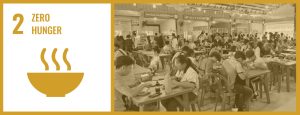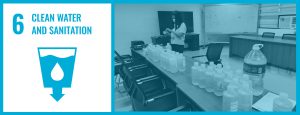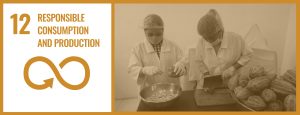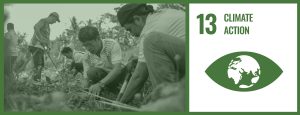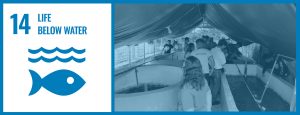2024 Research | SDG 1 – No Poverty
Research Projects
Project: Upscaling of Postharvest Processing and Shelf-Life of Oyster Mushroom Study: Processing of Mushroom Loaf
Proponents: Melody E. Lim, Arlene I. Remigio, Ma. Leonila Cabaccan
Abstract
This study aims to evaluate the acceptability of mushrooms as a meat substitute in loaf and siomai. The products were assessed based on appearance, flavor, texture, aroma, and overall acceptability, and a cost-return analysis was conducted for each treatment. Data were analyzed using a Randomized Complete Block Design (RCBD). Results revealed that the experimental treatments using pure mushrooms demonstrated comparable attributes – appearance, flavor, texture, aroma, and general acceptability – to the control group, with the 30 panelists rating them as “like very much”. However, the aroma of loaf made with varying proportions of mushrooms was not comparable to the control, receiving a “like moderately” rating. The highest net income was achieved in the pure mushroom treatment (T4), which the panelists rated as “likely slight”.
Project: Upscaling of Postharvest Processing and Shelf-Life of Oyster Mushroom Study: Processing of Mushroom Steamed Dumpling
Proponents: Melody E. Lim, Arlene I. Remigio, Ma. Leonila Cabaccan
Abstract
This study presents the results of a sensory evaluation conducted to assess the attributes of oyster mushroom gyoza, with participation from 50 evaluators. The gyoza were evaluated based on five sensory attributes: appearance, aroma, texture, taste/flavor, and general acceptability, using a 1-9 hedonic scale where 1 indicates ‘dislike extremely.” The results demonstrated that the gyoza had a mean appearance score of 7.6, indicating favorable visual appeal. Aroma received a mean score of 7.2, suggesting general appreciation but less impact on the overall experience. The texture was highly rated with a mean of 7.8, showcasing a successful combination of the soft wrapper and tender filling. The taste/flavor emerged as the standout attribute, achieving a mean score of 8.3, reflecting strong satisfaction attributed to the umami-rich filling of the oyster mushrooms. The overall acceptability score of 8.0 confirmed that the gyoza were well-liked by the evaluators. The findings highlight the strong visual appeal, favorable texture, and particularly satisfying flavor of the oyster mushroom gyoza, establishing them as a successful plant-based alternative to traditional meat-filled dumplings.
Developing Students’ Entrepreneurial Competencies among Undergraduate Students: The Case of Isabela State University-Echague
Proponents: Jayson G. Gollayan, Hunter Joseph C. Lim, Leah B. Bitao
Abstract
Entrepreneurship education has become an essential tool for equipping students with the necessary skills, mindset, and confidence to pursue entrepreneurial ventures and contribute to economic development. This study aims to assess the impact of compulsary entrepreneurship education on the development of personal entrepreneurial competencies (PECs) among undergraduate students at Isabela State University (ISU). The research focuses on comparing the entrepreneurial competencies of students from business and non-business clusters. Using the PECs framework,a quantitive survey was conducted across ten competency domains: opportunity seeking, persistence, commitment to work contract, demand for quality and efficiency, risk-taking, goal setting, information seeking , systematic planning and monitoring, persuasion and networking, and self-confidence. A 5-point Likert scale was used to measure the extent to which students exhibit these competencies. Statistical tools such as t-tests were employed to determine significant differences between the two groups. Results revealed that while business students scored significantly higher in opporutnity seeking, there were no substantial differences in the other nine competencies. Both business and non-business students demonstrated strong entrepreneurial competencies overall. The findings suggest that ISU’s entrepreneurship education program effectively cultivates entrepreneurial competencies across disciplines. An action plan is proposed to enhance the entreperneurship curriculum further, ensuring that students from all fields of study develop the necessary entrepreneurial skills to thrive in a competitive economic environment.
The Credit Risk Management of Agricultural Cooperatives in Isabela Province during the COVID-19 Pandemic
Proponent: Fler L. Madayag
Abstract
Cooperatives are an integral part of the economic framework. They are an important source of finance for people and companies of all kinds, acting as a safety net for savings. During the period of Covid-19 pandemic, these coopeartives are exposed to credit risk. Since implementing risk management techniques are expensive, cooperatives have found it difficult to mitigate credit risk, which might lead to a spike in deliquency rates and cause issues for the cooperatives’ financial position. This study, which combined qualitative and quantitative methods, examined the cooperative’s exposure to credit risk, its effectiveness in implementing credit risk management strategies, and the challenges that these sixteen agricultural cooperatives in Isabela encountered in mitigating credit risk. A four-point Likert scale survey questionnaire, an open and closed-ended interview questionnaire, and information from financial statements and annual reports were used to collect data. The study’s findings revealed that agricultural cooperatives in Isabela are exposed to low level of credit risk. It also showed that a broad spectrum of activities,including identification, evaluation, and mitigation, had been implemented to reduce credit risk. Furthermore, even if the majority of cooperative still face various challenges in implementing risk management.
“From Orchard to Bottle: Exploring the Potential of Locally Available Fruits for Sustainable Wine Production and Indigenous Vegetables for Mixed Juice Drink”
Proponent: Honeylyn D. Farala
Abstract
Fruits and vegetable are recognized as fundamental source of nutrients. The research study was conducted to determine the acceptability, marketability and nutritive value of locally fruit wine and mixed juice drink. The 9-point hedonic scale and 7-point hedonic scale was used to determine the acceptability level of mixed juice drink of wines and 5-point Likert scale for marketability of the wine and juice. The analyzation results of one-way classification of the Analysis of variance (ANOVA) showed that pomelo wine has a grand weighted mean ranging from 6.68 to 6.80, The turnip wine 6.74 to 6.75, mango wine showed varied ratings in which food experts (grand weighted mean = 6.51) and community people (6.50) and FSM students (6.36). The pineapple wine, has grand weighted mean score ranging from 6.61 to 6.74. This indicates that all the wines are acceptable in three group of respondents. Lastly, for the pipino wine, it received the lowest rating in which it received a rating ranging from 5.99 to 6.36 categorized as only acceptable. For mixed juice drink receives very acceptable in terms of appearance, color, aroma, and taste and extremely acceptable in terms of texture. For the marketability of the study, it is revealed that it has very high potential in the market.
“Nutritive Values of Slender Amaranth and Lemon Grass with Philippine Lime”
Proponent: Honeylyn D. Farala
Abstract
The study aimed to determine the nutritive value and shelf life of slender amaranth, lemon grass and Philippine lime aqueous extract mixed juice drink. The product consisted
of three treatments, treatment 1 150 grams of slender amaranth, 100 grams of lemon grass and 200 grams Philippine line, treatment 2 100 grams of slender amaranth, 150 grams
lemon grass, 200 grams Philippine lime, and treatment 3 50 grams of slender amaranth, 200 grams of lemon grass, 200 grams Philippine lime. The nutritional value of the study
underwent a process and assessment conducted by the Department of Science and Technology (DOST) III and found out that there are ____________________________________________________. The study revealed that mixed juice drinks stored at room temperature have a longer shelf life. The study showed that the mixed juice drink has market potential.
“Marketability of Slender Amaranth and Lemon Grass with Philippine Lime”
Proponent: MACARIO Q. TAMUNDONG JR.
Abstract
The study aimed to determine the marketability of Slender Amaranth and Lemon Grass with Philippine Lime. The product consisted of slender amaranth, lemongrass, and Philippine lime with different formulation. The descriptive – experimental method of research was used with the survey questionnaire as the main data gathering instrument. The
study used five-point Likert rating scale to evaluate the marketability. The statistical tools used in the study were weighted mean and ANOVA. The findings indicate that all treatments are perceived positively across the respondent groups. However, there are no statistically significant differences in consumer demand, supply availability, or production
costs among the three treatments, as all p-values exceed the conventional threshold of 0.05. Lastly, the treatment 3 being the most favored formulation due to its higher mean scores across all evaluation criteria.
“A Taste of Passion: Acceptability of Coconut Curd (Latik) Macaroons”
Proponent: Ma. Theresa R. Respicio
Abstract
“The study aimed to determine the acceptability of banana cake, carrot cake and macaroons. The experimental method of research was used with the survey questionnaire as the main data gathering instrument. The study used the nine-point Hedonic rating scale in evaluating the product’s acceptability in terms of appearance, color, aroma, taste and texture. Twenty (20) Food and Service Management students, twenty (20) food experts, and twenty (20) community people a total of sixty (60) were the respondents of the study. The statistical tools used in the study were weighted mean and standard deviation. Results of the study revealed that the Macaroons had the highest acceptability and with consistent rating across all the respondents, thus it indicates that the coconut macaroons have the potential to be a viable and appealing local product in the market. Meanwhile the acceptability of the banana cake was also very high which indicated that it could also be a dependable option. However, with regards to the carrot cake, refinement and adjustment are needed to meet community people’s preference while not affecting the positive perception of the FSM student and food experts. In the aspect of nutritional content, all baked products”
Capturing the Most Significant Changes From College Extension Projects of ISU Cabagan through Clients’ Narratives
Proponents: Rosalinda S. Guingab, DComm; Myrna C. Cureg, PhD; Regina Blair S. Santiago, MSDC
Study 1: Identification and Screening of College Extension Projects
Study 2: Stories of Most Significant Changes from Mabuwaya-Funded Extension Projects
Study 3: Development of IEC Materials Featuring the Most Significant Stories of Change from the College Extension Projects of ISU Cabagan
Abstract
Using the Most Significant Change (MSC) as its framework, this research documents community perspectives on the Save Our Species extension project’s socio-cultural and economic impacts. Key themes include changes in perceptions toward the Philippine crocodile, increased community participation in conservation, cultural and economic effects of conservation, empowerment of indigenous communities, establishment of the roles of local sanctuary guards, and provision of other livelihood opportunities. The findings offer insights into how Communication, Education, and Public Awareness (CEPA) activities on conservation, as part of an extension project, can foster sustainable development and provide guidance for future initiatives aimed at ensuring the long-term preservation of endangered species.
Comparative Analysis of the Profitability of Small-Scale Monoculture and Diversified Yellow Corn Production Farms in Cabagan, Isabela
Proponent; Michelle Ann M. Calubaquib,Ph.D
Abstract
The study aimed to compare the profitability of small-scale monoculture and diversified yellow corn production farms in Cabagan, Isabela. It sought to characterize the socio- demographic profile of farmers, compare their farming practices, and determine profitability. The research was conducted through house-to -house survey of 30 farmers engaged in monoculture and 30 farmers practicing diversified farming. The findings revealed that oldr farmers predominantly practice both farming systems, with monoculture farming involving more male farmers (70%) and diversified farming having a higher proportion of female farmers (60%). Most farmers in both systems are married and have educational background ranging from elementary to high school levels. Income levels are generally low, with diversified farming showing a broader income distribution. In term of cultural management practices, monoculture farmers rely more on tractors (80%), mechanical seeders (75%), and herbicides (90%), ehile diversified farmers prefer traditional methods such as manual planting (65%), and araro (plowing)(60%). Monoculture farming incurs higher cash cost due to greater dependenceon fertilizers and labor, leading to potential soil degradation .In contrast, diversified farming employs a variety of water sources and integrates more manual labor in seed preparation, planting, and water management, resulting in lower input costs. The gross profit margin ratio for monoculture farming is 0.82, meaning they retain 0.82 centavos per every peso of income after covering the cost of goods sold, compared to 0.67 centavos for diversified farmers. Monoculture farming offers higher immediate profit margins but demands more input and is more susceptible to soil degradation and pest issues. Diversified farming, while yielding lower profit margins, provides sustatinability benefits through reduced input cost and labor savings.
Development of Sesame Based-Product in Cabagan, Isabela
Proponents: VILMA U. ATALIN, DR. SAMUEL R. SIMON, MR. JONATHAN S. BALOG, MS. KRISTINA MANALIGOD, MR. JOHN PAOLO N. FAUSTINO, MS. MARIA SABRINA B. ESTAVILLO
Abstract
Sesame (Sesamum indicum L.) seeds has been utilized mostly for oil processing and often as added ingredients for savory dishes or toppings of baked bread & biscuits. This study aimed to innovate food products based from sesame seeds in order to introduce and promote the utilization & increase consumption of this highly acclaimed nutritious seed. Various trial-and-error processing was conducted specifically the ratio of ingredients as well as the variety (Black or Brown variety) better suited for each product being developed. After the rigorous trials, four products were developed which are: butter, brittle, and polvoron. Through passing the microbial tests at Department of Science & Technology- Regional Standards and Testing Laboratory (DOST-RSTL), the products underwent single-blind sensory evaluation with seventy-five (75) respondents coming from various locations, gender, and age. The nine (9) hedonic scale were used as tool in sensory evaluation to assess and measure the likability or consumer preference for food products as to aroma, texture, smell, and taste. Results showed that for Sesame Butter, the Brown variety exceeded other variants by gaining highest percentage overall acceptance with 32.3% of respondents rated like extremely and 29.00% like very much. For the Sesame brittle, since the Black variety of sesame did not pass the microbial tests only the Brown variety was compared to the control (commercially available product) and this resulted with overall acceptance of the Control higher than the Brown Sesame variety but it can be noted that the Brown sesame brittle obtained higher rating for texture (32.00%) and equal rating for aroma (34,67%). The scenario for Sesame polvoron is that, Brown variety of sesame did not pass the microbial tests that is why only Black variety is compared to the Control wherein the latter consistently surpassed the black sesame polvoron in all areas of evaluation. Though various food products can be developed and innovated for sesame seeds, the results inferred that the acceptance of sesame (Black & Brown variety) is widely influenced by the appearance of the product.
Development and Kiwit Fish (Asian Swamp Eel) as Delicacy
Proponent: Glorilyn B. Alejandro
Abstract
The main objective of study was to develop delicacies from “Kiwit” or Asian swamp eel meat. Specifically, it aimed to determine the requirements and processes in making the following Asian swamp eel food products. The study also determined the level of acceptability of the developed food products in terms of appearance, taste and flavour as perceived by its respondents. The food product development began with the preparation of the Asian swamp eel. Dressing the eel fish includes salting, removal of head and tail, washing with running water, removal of entrails, skin removal, and deboning. After the first stage of preparation, the process of food product development comes next. The developed food products were rated as highly acceptable by the respondents in terms of appearance, taste and flavour. In conclusion, the processed Asian swamp eel meat and skin can be developed into acceptable food products. The food products can be enhanced by adding other organic ingredients like herbs and seasonings to further improve its taste and aroma.
BotCoin: Bottle-Coin Vendind Machine
Proponents: Kelvin Kris C. Gonzales and Alvin B. Tañeza
Abstract
BotCoin: Bottle-to-Coin Vending Machine is a technological solution designed to alleviate the growing issue of plastic and can waste in San Mateo, Isabela, Philippines. This clever vending machine converts throwaway bottles/cans into cash, encouraging residents to recycle and promoting environmentally friendly activities. BotCoin aims to make recycling more accessible and engaging by combining technology and financial incentives, particularly among younger generations who are more likely to respond to tech-based solutions. However, numerous challenges and issues have emerged in waste segregation practices in many communities. In recent years, local government has noticed an alarming rise of plastic bottles/cans garbage in public places, rivers, and landfills. Despite various environmental awareness programs, plastic recycling rates are still low, and inappropriate disposal contributes to environmental damage. Furthermore, the lack of a formal waste management system and readily available recycling programs makes it difficult for residents to actively participate in plastic trash reduction. The increasing prevalence of plastic bottles and cans in the Philippines, despite existing waste management policies, highlights a significant challenge in environmental sustainability. The country is grappling with a substantial volume of plastic waste, with Quezon City alone generating approximately 262 tons of plastic waste daily, indicative of broader national trends (Sidhu et al., 2021). The Philippines ranks as the third-largest contributor to global mismanaged plastic waste, following China and Indonesia, which underscores the urgency of addressing this issue through effective waste management strategies (Deocaris et al., 2019). Despite the enactment of the Ecological Solid Waste Management Act of 2000 (Republic Act 9003), which aims to enhance waste management practices, the effectiveness of these policies remains questionable. A study indicates that the lack of public awareness and inconsistent policy implementation are critical barriers to successful waste management (Chen et al., 2021). With this, the BotCoin vending machine provides a localized, small-scale solution that is both inexpensive and feasible for rural areas such as San Mateo, Isabela. This innovation also addressed the gaps to other researches on incentivized recycling systems in developing countries, where economic and infrastructure constraints frequently impede effective waste management techniques. This also represents a transformative approach to recycling and waste management, aligning individual and collective interests. It empowers individuals to contribute to a sustainable future while earning rewards for their actions. As more of these innovative machines will soon populate our towns/cities, we can look forward to a world where recycling pays dividends for both our wallets and our planet, making the Earth greener and wealthier, one recyclable at a time.
Fuzzy Logic Approach in Predicting Egg Production on Laying Hen in an Uncontrolled Temperature
Proponent: Dr. Cherry R. Gumiran
Abstract
The primary factors influencing egg production in hens are age, body weight, feed intake, and quality. However, heat stress and disease are significant factors that
can negatively impact egg production, leading to economic losses and affecting egg quality, weight, and shell quality. To address these issues, a fuzzy logic model was
developed using the Mamdani style, incorporating six input variables: age, body weight, feed intake, feed quality, temperature, and disease. The model aims to predict
the egg production rate of individual hens, particularly in uncontrolled temperature environments and categorizes the output into three levels: low, medium, and high. The
model consists of 486 rules that quantify the relationships between the input and output variables. Studies have shown that temperature is the primary factor affecting egg
production, particularly in uncontrolled temperatures. When the temperature exceeds the normal range, it can significantly impact the hen’s appetite, leading to a reduction
in egg production. However, if the input variables are within the standard ranges, excluding age, the rate can still be high even for young hens (20-30 weeks old).
Designing and Construction of Posture Brace Integrating Backpack Functionality
Proponent: Ronald B. Isidro Jr
Abstract
This paper explores the design and construction of a posture brace with integrated backpack functionality. The device is intended to correct posture and reduce the risk
of back pain while also serving as a functional, everyday backpack. This dualpurpose solution is aimed at students and professionals who carry heavy loads, seeking to improve spinal alignment and reduce the strain on muscles. Prototyping and testing demonstrate that this design offers significant ergonomic advantages over traditional backpacks.
Design and Production of Abdominal Brace Contraption Merged with the Function of Utility Apparel
Proponent: Ronald B. Isidro Jr
Abstract
The researcher explored the design and production of an abdominal brace integrated with utility apparel functionality. The aim of the research is to create a contraption that not only provides abdominal support but also incorporates practical storage solutions, enhancing convenience for users who require additional physical support. Prototyping and evaluation of the product indicate the potential of such hybrid designs to improve both health and productivity in daily life.


